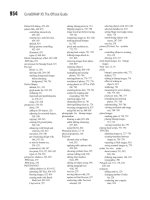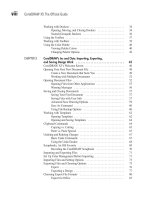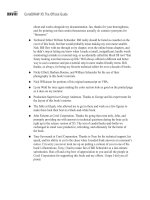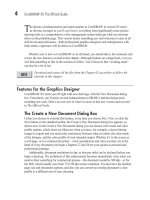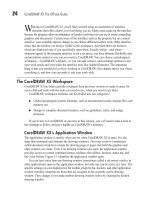CorelDRAW X5 The Official Guide part 80 pdf
Bạn đang xem bản rút gọn của tài liệu. Xem và tải ngay bản đầy đủ của tài liệu tại đây (553.4 KB, 10 trang )
deleted because it’s the Source Object, and you didn’t choose to leave it. Apparently
the bottle has not changed, but there is a perfect cutout duplicate of the top of the
bottle resting on top of an unchanged bottle; you’re halfway there—you need to trim
away part of the bottle using the new intersect object. Switch to the Pick tool now.
4. Click on the top of the bottle to select the product of the Intersect operation in step 3
(don’t worry; it’s hard to see that it’s a separate object). Choose Trim from the
Shaping docker’s drop-down list, check Leave Original Source Object(s), and
uncheck Leave Original Target Object(s). Click the Trim button and then click the
bottle, and the beer bottle is now actually two separate pieces. See the following
illustration for the docker settings for steps 3 and 4. Now it’s on to transparency.
Ill 24-7
5. Select the top part of the shape, and then choose the Interactive Transparency tool from
the Blend group of tools on the toolbox. Choose Uniform from the selector drop-down
on the property bar, and then drag the Opacity slider on the property bar to about 50%.
As you can see here, your editing work resulted in quite a convincing illustration. You
can see Bob’s logo in the background peeking through semitransparent glass; the
background is even tinted a little from the green of the object on top of it.
754 CorelDRAW X5 The Official Guide
Separate object (not obvious)
Ill 24-8
6. Here’s the piece de resistance: with the bottle selected and not the semitransparent
piece, choose the Drop Shadow tool. Click toward the bottom of the bottle image to
define an anchor for the shadow and then drag up and to the right.
7. Click-drag the end marker of the shadow so the shadow ends closer to the bottle. Then,
because the bottle should be casting a deep green (not black) shadow, click the Shadow
Color flyout on the property bar, and then from the palette choose a deep green.
Ill 24-9
CHAPTER 24: Advanced Photography Techniques with CorelDRAW 755
24
8. Well, oops. The area you trimmed in step 4 is not part of the shadow—there’s a hole
in the shadow where there should be a lighter green, because a shadow cast by green
glass through beer would be a little darker than a shadow cast through green glass
alone. No problem; you draw a fill object for the missing part of the shadow as shown
here, fill the object with green, and then give it about 50 to 60% Uniform transparency.
Ill 24-10
Blending Photos with Transparency
You’ll learn in Chapter 25 how to use PHOTO-PAINT to mask the exterior of an object in a
photo. For the moment, let’s imagine that the Tree.png file you’ll work with in the following
steps was created by masking everything except the tree in the photo, and then you saved it
as a PNG file with transparency using PHOTO-PAINT.
You know now that an image can have transparent areas, and that you can use
CorelDRAW’s Transparency tool to make any object on a page partially transparent. The
steps that follow show you how to create surreal, completely professional photo-retouching
with two images you graft into one another with only one CorelDRAW tool.
Creating a Transition Between Two Images
1. Press CTRL+N to create a new file; accept the default standard letter page size and
specify portrait orientation.
2. Import ThumbsUp.jpg. JPEG images do not retain resolution information, so you
need to click-drag the loaded cursor after clicking Import to scale the imported
image to the 11" height of the page.
756 CorelDRAW X5 The Official Guide
3. Import Tree.png. PNG files can (in some cases) retain image resolution information,
so all you need to do is click the loaded cursor on the page.
4. With the Pick tool, position the tree so its trunk fits over the thumb in the underlying
photo.
5. Choose the Transparency tool from the Blend group of tools on the toolbox.
6. Click-drag starting from around the thumbnail area in the underlying photo to just above
the trunk on the tree. You should see the amazing transformation between the guy’s
thumb and the trunk of the tree (see Figure 24-10). If the Start and End points for this
Linear transparency aren’t perfect, you can adjust the Start and End points with the
Transparency tool cursor.
7. Unfortunately, the guy’s thumb doesn’t taper toward the top like the tree trunk does;
some of the thumb is visible, ruining the special effect. Choose the Bezier pen tool
from the toolbox, and then draw a closed shape whose right edge matches the contour
of the tree trunk’s left side. Fill it with the same color as the background of the thumb
CHAPTER 24: Advanced Photography Techniques with CorelDRAW 757
24
FIGURE 24-10 Create a blend between two photos to present unique and visually arresting
imagery.
Create shapes to
hide top of thumb.
Linear transparency
photo—choose the Color eyedropper tool from the toolbox, click over the background,
and then click the paint bucket cursor on the object you drew.
8. Perform step 7 on the right side of the thumb, after drawing a second object.
9. Remove the outline of both shapes (select them both) by right-clicking the No Fill
color well on the Color Palette.
10. With both objects selected, press CTRL+PAGE DOWN to put them behind the tree, yet
in front of the thumb photo.
11. Read Chapter 12 on working with text, because this image would make a terrific
magazine cover.
Ill 24-11
758 CorelDRAW X5 The Official Guide
Bitmaps to Vector Art: Using PowerTRACE
You can export both vector art and bitmaps to bitmap file format, but once in a while you’ll
need to go the other way: taking a bitmap and making vector art from it. Many design
professionals are faced daily with clients who want to use their logo for a truck sign or a
high-resolution print ad, when all they can provide the designer is a really pathetic GIF copy
from their web page.
Fortunately, designers don’t have to reconstruct logos by hand—Corel PowerTRACE
has been reworked in version X5 to become a highly accurate utility that often produces
a vector equivalent of a placed bitmap that requires no hand-tweaking afterward. What
PowerTRACE does is simple: it creates a vector version of the selected bitmap. How
PowerTRACE does this is not easy to explain, but if you understand the “how,” you’ll be
better prepared to choose options before making a vector copy of an imported bitmap. In a
nutshell, PowerTRACE examines the bitmap based on the criteria you specify in the dialog
and then seeks edges in the bitmaps that show a clear and marked difference in color and/or
brightness between neighboring pixels. PowerTRACE then creates a vector line at this
neighboring region, continues to create a closed path (with the Centerline option chosen, it
creates open paths), and fills the path with the closest color match to the pixels inside the
area it creates. The following sections take you through the operation of PowerTRACE and
offer suggestions on settings and when and why you’d use this handy feature.
Bitmap Conversions for Logo Alterations
Sometimes you’ll want to use PowerTRACE to rework an existing logo that’s in bitmap
format. Suppose SilverSpoon.png, a good, clean graphic, is the logo for a caterer that was
bought out yesterday by Phil Greasy, and Phil likes the logo but wants the name changed
to…you guessed it. You use settings for PowerTRACE to make a vector conversion of the
logo covered in the following section, but this is a prime example of “knowing your fonts”
(covered in Chapter 13). A lot of times it’s a futile endeavor to trace typography in a logo:
it’s much easier and provides cleaner results just to recast the text using the same or a
similar font.
Pre-Touching: Use PHOTO-PAINT
for Cleanup Before Tracing
The Silver Spoon logo you’ll have PowerTRACE convert so you can alter the logo for the new
owner is a detailed and complex one. There are four or five areas in the logo that you’ll need to
assist PowerTRACE with by manually editing the logo before auto-tracing it. Your own artistic
eye is hooked up to your brain, and it can discern the edge between the black outline around
“Silver” and the black background checkerboard. PowerTRACE, on the other hand, doesn’t
have eyes and doesn’t have a brain (these features are expected in CorelDRAW X475).
Therefore, you will make life a lot easier for yourself if you use Corel PHOTO-PAINT to
erase the areas—working to the outside of the outline around “Silver”—so there is a gap and
CHAPTER 24: Advanced Photography Techniques with CorelDRAW 759
24
so PowerTRACE creates separate objects for the word “Silver” and for the checkerboard
background.
This logo is probably the hardest one you’ll encounter professionally to use PowerTRACE
on for clean-up work and alterations. If you succeed at this fictitious example, your paying
gigs will be a charm. These are really quite easy steps, and shortly you’ll see how little sweat
you have to break to dramatically alter the logo.
Working Between CorelDRAW and PHOTO-PAINT
1. In a new document in CorelDRAW, import the Silver Spoon.png image. Click the
loaded cursor to place the bitmap at its original size.
2. Click Edit Bitmap on the property bar. In a moment, PHOTO-PAINT loads with
Silver Spoon.png displayed in a document window.
3. Choose the Eraser tool from PHOTO-PAINT’s toolbox. On PHOTO-PAINT’s
property bar, type 10 in the Size field to set the diameter of the Eraser tool. Then set
the Feather amount to zero (0). Doing this gives you a small, hard tool for erasing
areas, exposing the default white background color.
4. The bottom left of the S, the dot over the i, the upper left of the l, the top and bottom
left of the e where it touches the outline of the spoon, and the bottom and right
portions of the r all touch what you can see as black background areas. Refer to the
illustration here, and carefully erase areas outside of these characters, creating a
white gutter between background elements touching the black border around the
letters in “Silver”.
Ill 24-12
760 CorelDRAW X5 The Official Guide
Erase these areas.
5. When you’re finished, choose File | Exit or press ALT+F4 to close PHOTO-PAINT.
Click Yes to save changes, PHOTO-PAINT closes, and you’re returned to
CorelDRAW with your edits made to the copy of the logo you imported.
6. With the bitmap selected, click Trace Bitmap, and then choose Outline Trace | High
Quality Image. It’s not time to trace yet, but it’s time to explore your options before
tracing.
PowerTRACE Options
After you import and select the bitmap, you have the option to Quick Trace the bitmap, or to
get more specific about the final traced object’s quality and fidelity.
This logo has no dithering and no aliased edges. Therefore, the PowerTRACE can be set
for less smoothing and greater precision. As you can see here, the logo has no transparent
background, but because you’ll trace it, you can automatically delete its white background,
a little perk for your client.
●
Trace Type You can choose Outline or Centerline from this drop-down. Outline is
the method that produces objects based on areas of color similarity in the bitmap.
Centerline is a good option when your source bitmap is calligraphy or a technical
drawing; this option generates open paths to which you can assign different widths
and styles after the trace is placed on the page.
●
Type of Image This is a convenience based on what many people call different
types of bitmap art. Depending on your choice—from Line Art to High Quality
Image—PowerTRACE renders a few objects or hundreds. You can customize a Type
Of Image setting by altering other settings, and you can also use an “inappropriate”
setting type for your imported image. No two images are alike, and you might be
surprised at the hi-fi rendering of a piece of clip art you trace using, for example, the
Line Art Type Of Image setting.
●
Colors On this tab you can set the number of unique colors PowerTRACE evaluates,
from 1 (which will render a stencil of your original) to a varying maximum of unique
colors, which you can limit by typing in a value. You can specify the color mode for
the trace; you’d choose CMYK, for example, if you needed a trace that could be sent
as an EPS file to a commercial printer. Generally, your best bet is the RGB color
mode. You can also sort the colors to be used by how frequently they appear in the
original bitmap, or by similarity. Additionally, if you intend to replace a color when
you edit the traced result, you can do so by clicking a color well and then click Edit.
CHAPTER 24: Advanced Photography Techniques with CorelDRAW 761
24
●
Settings This tab, shown in Figure 24-11, is used to define how tightly and accurately
you want PowerTRACE to render the bitmap as vector object.
●
Detail You set the overall complexity of the trace with this slider. Higher
values cause PowerTRACE to carefully evaluate the bitmap, while lower Detail
settings can produce a stylized, posterized trace with fewer colors and far fewer
groups of objects.
●
Smoothing This setting controls both the number of nodes along paths and, to
a lesser extent, the number of objects the trace yields. A higher smoothing value
is good when your bitmap import is a GIF image that contains a lot of noise,
dithered colors, and jagged edges.
●
Corner Smoothness Use this setting depending on the visual content of your
imported bitmap. For example, a photo of a sphere probably doesn’t require any
corner smoothness. However, a photo of a bird’s feather will certainly have a lot
of abrupt color and geometry changes—you’d want to use a very low Corner
Smoothness setting to accurately represent the sharp turns and corners that make
up a feather.
●
Delete Original Image Upon finalizing the trace, CorelDRAW can delete the
image it traced, leaving only the vector objects on the page. This is not usually a
good idea—what if you’re unhappy with the first trace you perform? Leave this box
unchecked.
●
Remove Background Usually you’ll want to check this box. When an imported
image such as this logo is floating in a background of white, Remove Background
doesn’t make the background a huge white rectangle. Optionally, any color can be
removed from the final trace by choosing the Specify Color radio button and then
using the eyedropper to choose a color from the preview window.
●
Automatically Choose Color This option chooses the color in the image that is
removed from the final trace. This option can be useful as a quick method for
separating the foreground areas of interest from a background you want removed,
but as with anything “automatic” in a software program, you’re best off previewing
what’s been chosen before clicking OK.
●
Remove Color From Entire Image If you select this option, every instance of
the chosen color will not be traced and the result will be empty areas in your vector
version of the bitmap. This result is not always desired, so give this item some thought.
If, for example, there’s a yellow star on a blue balloon, and the background is also
yellow, both the star and the background will not be traced.
●
Merge Adjacent Objects of the Same Color This option makes one object instead
of several if the bitmap contains areas of almost identical color in neighboring
regions. If this option is chosen, Remove Object Overlap cannot be used.
762 CorelDRAW X5 The Official Guide
●
Remove Object Overlap Most of the time, you’ll want to leave this box
unchecked. If you do choose to enable Remove Object Overlap, there might be
visible gaps between the resulting grouped vector shapes, making it hard to put a
solid background behind your trace without the background color or texture peeking
through. If this option is chosen, the Group Objects by Color option cannot be used.
●
Group Objects by Color This is a handy feature that automatically groups
identically colored objects after you click OK to make the trace. You can then
choose a different color and apply it to the entire group, delete an entire group of
objects of identical fill, and not have dozens of objects that can be accidentally
moved lying all over the page.
●
Trace Result Details This area on the dialog predicts how many objects (Curves),
how many Nodes, and how many different Colors will be produced. As a guideline,
if the results show more than 200 objects will be created, think twice. It’s a large
number of objects to edit, and the resulting trace could be a challenge to work with.
CHAPTER 24: Advanced Photography Techniques with CorelDRAW 763
24
FIGURE 24-11 Use the features and settings in PowerTRACE to create an optimized group of
vector objects based on the bitmap.
Controls number of
colors and objects
produced
Produce objects
or lines
Type of bitmap/quality
of original bitmap
Controls the
tightness of
trace to color
edges in bitmap
Controls the
tightness of cusp
nodes produced
at traced corners
Removes exterior
of traced object
Removes color
of your choice
Groups identically
filled objects
Might create gaps
